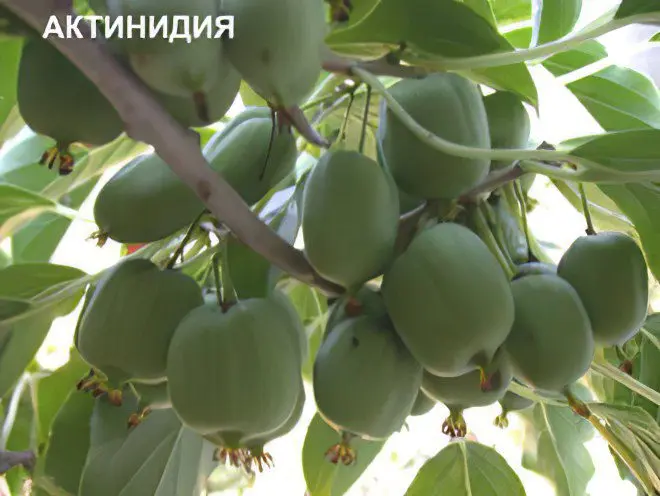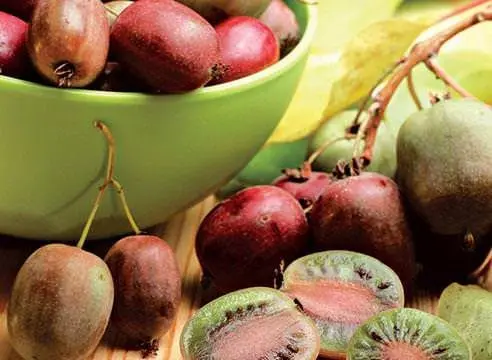Contents
Useful properties, use of actinidia and treatment with it
Botanical characteristics of actinidia

Actinidia – a perennial plant from the genus Liana. It has trunks that look like woody stems. The leaves of actinidia are finely toothed, green, with short, hard villi on the underside of the leaf. The leaf shape is heart-shaped. There are also ornamental species with pink or yellow coloration.
Actinidia flowers – white or cream in color, collected in brushes, practically do not smell. The fruits, depending on the variety, can be of different shapes, and their color can be either green or brown-brown.
The tropical forests of Southeast Asia are considered to be the birthplace of such a useful plant as actinidia. It is there that the largest number of actinidia species is found – about 30. The flora of Korea and China also abounds with this plant. The most common 4 types of actinidia:
Actinidium colomicta, popularly christened “Amur gooseberry”, is a tree-like vine, reaching a height of six meters. It grows mainly in cedar, spruce and fir forests. Often found in Japan, China and Korea. The fruits are green, have an oblong rounded shape. The size of the fruit is about three centimeters. The pulp is sweet, fragrant, tastes like gooseberries. The fruits are harvested slightly immature to avoid falling off, and are mostly consumed fresh.
Actinidia arguta – its other name is “sharp actinidia” – is one of the largest species of this genus. It grows, as a rule, in coniferous or mixed forests. This type of actinidia is most widely distributed in the Far East, in Russia and China. In favorable natural conditions, it lives for about 100 years. The fruits are small in size – 3 centimeters long and about 2,5 wide. The pulp has a sweet taste and a subtle smell of pineapple. The type of argut is the most fruitful.
Actinidia polygamous has many other names: “nosed”, “polygamy”, “sharp-fruited”. In nature, it is most often found in mixed forests of Primorye and the Far East. The bark is brown, the flowers are white, fragrant. The fruits change color during ripening from light green to orange. This type of actinidia is not entirely edible due to the specific, pungent taste of the fruit pulp.
Actinidia sinensis – otherwise delicacy actinidia, as well as the most common and common name – “kiwi”. Under natural conditions, this actinidia is common in the mountains. The birthplace of kiwi is Western and Central China. The liana itself can climb a tree to a height of up to 30 meters. The leaves are large, pubescent, the upper part of the leaf is green, and the lower part is reddish. Flowers are yellow or orange. Fruits are pubescent, oblong, fragrant. The flesh of the berry is green or yellow, very tender, soft and juicy in taste. The high content of vitamin C and potassium in Chinese actinidia makes kiwi the most effective remedy for beriberi, iodine deficiency and hypertension.
Cultivation and harvesting of actinidia
Actinidia does not like bright light, so it is recommended to plant it in poorly lit places. For actinidia bushes, protection from strong winds, hail and the sun is necessary, so the presence of a number of deciduous trees that give shade is only good for her. Actinidia must also be protected from spring, autumn and winter frosts. To do this, actinidia bushes should be covered for the winter with spruce paws, especially young plants, since they have reduced winter hardiness.
In summer, actinidia care is limited to frequent watering, spraying and regular feeding.
The rest of the care is no different from caring for other fruit plants: timely pest control, regular weeding, loosening and fertilizing.
If actinidia bushes grow separately from trees, stems and shoots must be tied to poles or wire. It is also important to monitor the growth of branches: a strong thickening of the plant should be avoided by periodically removing infertile or dying branches. Pruning is best done in the fall.
For medicinal purposes, the leaves, fruits, flowers and bark of actinidia are harvested in the usual way. Flowering continues on average from May to June, and fruiting ends only in October. For harvesting actinidia fruits, it is not recommended to use metal utensils, since interaction with it destroys vitamin C in the fruits. Therefore, it is preferable to store actinidia fruit blanks in glassware and in a place protected from light, since the influence of sunlight contributes to the destruction of biologically active substances.
Useful properties of actinidia

Actinidia is valuable in a large number of minerals, vitamins and trace elements. The composition of the mature actinidia fruit contains a large amount of water, fiber, starch, carotene, reducing sugars, pectins, sucrose, dyes and organic substances. It is precisely due to its chemical composition that actinidia is a concentrate of vitamin C, because in terms of the content of this vitamin in fruits, it surpasses lemons, oranges and black currants, yielding only to several types of rose hips. The content of vitamin C in actinidia increases with the maturation of the fetus and reaches its maximum amount during its maturity. In the fruits of overripe actinidia, the amount of vitamins is much lower. Basically, the concentration of vitamin C is concentrated in the juice and pulp of the fruit. The fruits also contain vitamins P and A, and actinidia seeds are rich in various fatty oils.
A favorable combination of polyphenols and ascorbic acid, that is, acidity and sugars, in the composition of actinidia allows the use of its fruits both fresh and processed, since biologically active substances are perfectly preserved in dry and frozen fruits. Both fresh and canned fruits are very tasty and healthy, so actinidia is actively used in the preparation of syrups, jelly, compotes, juices, jelly, jam, jam, marshmallows and marmalade.
Fruits, flowers, leaves and bark of actinidia are of great therapeutic and dietary importance. Actinidia is used for diseases of the digestive system, scurvy, whooping cough, anemia, lung diseases, chronic constipation, worms, stomach neurosis, bronchitis, tuberculosis, rheumatism and paralysis. Also, its fruits regulate metabolic processes in the body and eliminate vitamin deficiency. Decoctions are used for caries. In the bark of the plant, the content of tannins and cardiac glycosides was found, so actinidia, among other things, can be used for dizziness, frequent headaches, as a sedative, analgesic, hemostatic, expectorant and tonic.
The use of actinidia
To regulate high blood pressure you need to eat 3-5 fruits of actinidia per day. Effective action is achieved due to the increased content of potassium in it.
RџSЂRё fever Juices and decoctions based on actinidia fruits will become an indispensable tool for quenching thirst.
Actinidia is an excellent helper for indigestion, belching, heaviness of the stomach and heartburn, as it contains enzymes that stimulate digestion, therefore, by eating a few fruits of actinidia, you can get rid of discomfort after eating. And the biologically active substance actinidin promotes the rapid digestion of meat and has a mild laxative effect.
In addition, the use of two to three actinidia berries per day satisfies the daily human need for vitamin C.
Actinidia treatment

To prepare an infusion from the leaves, it is necessary to grind the leaves or flowers of actinidia and pour boiling water over it. For 20 grams of raw materials, 200 ml of boiling water is required. Then the mixture is infused for 15 minutes in a water bath, and then cooled and filtered. Take the infusion should be three times a day for 1/3 cup. This infusion is used to relieve symptoms of angina pectoris and rheumatism.
Actinidia berry infusion recipe very simple: you need to take one tablespoon of berries and pour a glass of boiling water. This infusion is recommended to be taken twice a day, 100 ml. It is used as a general tonic and in violation of cerebral circulation.
Decoction of dried berries actinidia: 2 tablespoons of dry berries must be poured with boiling water (about 1 liter) and left to infuse for one night in a thermos. It is recommended to drink a decoction three times a day before meals, 1 glass. The remedy is used for diseases of the gastrointestinal tract, anemia and for violations of metabolic processes in the body.
A decoction of actinidia bark: crushed bark (20 g) should be poured with boiling water (200 ml), then insist in a water bath for 30 minutes, cool and strain. This decoction should be consumed after meals – three times a day, two tablespoons.
Infusion from the roots actinidia obtained by evaporating water to a minimum content. The roots must be cleaned, crushed, poured with boiling water and kept in a water bath until a strong concentrated infusion is obtained. It is widely used to treat stomatitis and inflammation of the gums. It is also used in the form of tampons, lotions and douches for female inflammatory processes.
Concentrated berry infusion actinidia is used to prevent cancer and the formation of metastases, since actinidia fruits contain vitamin Q, which inhibits the growth of cancer cells. Infusion-concentrate is recommended to be taken after meals in small doses.
In the treatment of beriberi, to increase appetite and general strengthening of immunity, use actinidia fruit juice. Due to the high content of vitamin C in actinidia, it is necessary to take fruit juice with caution, since the acid is contraindicated in people with kidney disease, gastritis and peptic ulcer. Therefore, it is recommended to use actinidia juice with ice or diluted with water.
But fresh actinidia is most useful, because by taking three fruits daily, many health problems can be easily prevented. And the fruits grated with sugar will become a healthy treat for children and adults.
The external use of actinidia is also widespread.
Ointment from fruitin actinidia. For its preparation, the fruits of bitter plant varieties are used, for example, polygamous actinidia. Pounded fruits must be mixed with a fat base (pork fat is suitable) and crushed mustard seeds. This ointment has a healing and restorative effect and is used for massages after fractures.
Root decoction and leaf decoction used for hot wrapping with sciatica, gout, rheumatism, with joint and spinal pain.
Juice and peel actinidia have wound healing and regenerating properties. Therefore, lotions and applications from juice are used to treat wounds that do not heal for a long time and with wet eczema. Lotions should not be kept on the skin for more than two hours.
Contraindications to the use of Actinidia
Treatment with decoctions, infusions or fruits of actinidia is not recommended for people suffering from thrombophlebitis, varicose veins and with increased blood clotting.
When eating a large amount of fresh actinidia fruits, an eating disorder may occur, which is eliminated after a while if the product is no longer eaten.
Also, a contraindication to the use of actinidia can be individual intolerance. It can cause an allergic reaction, reaching a high degree of severity.









